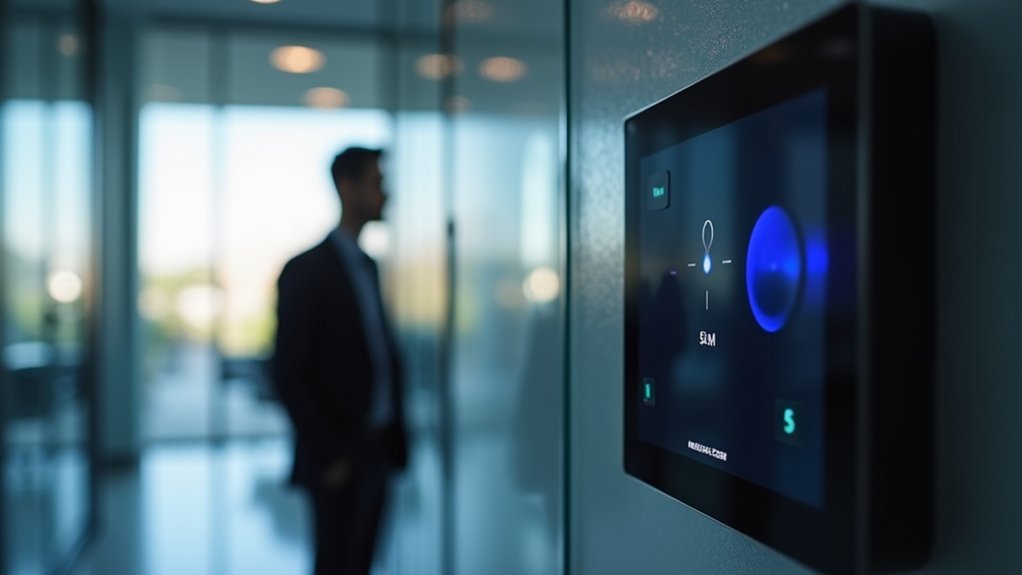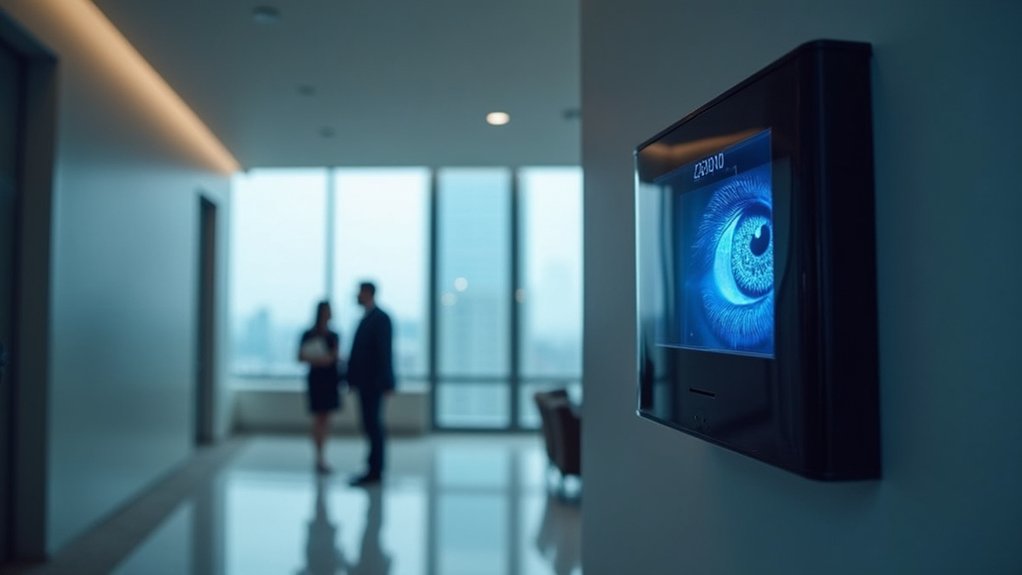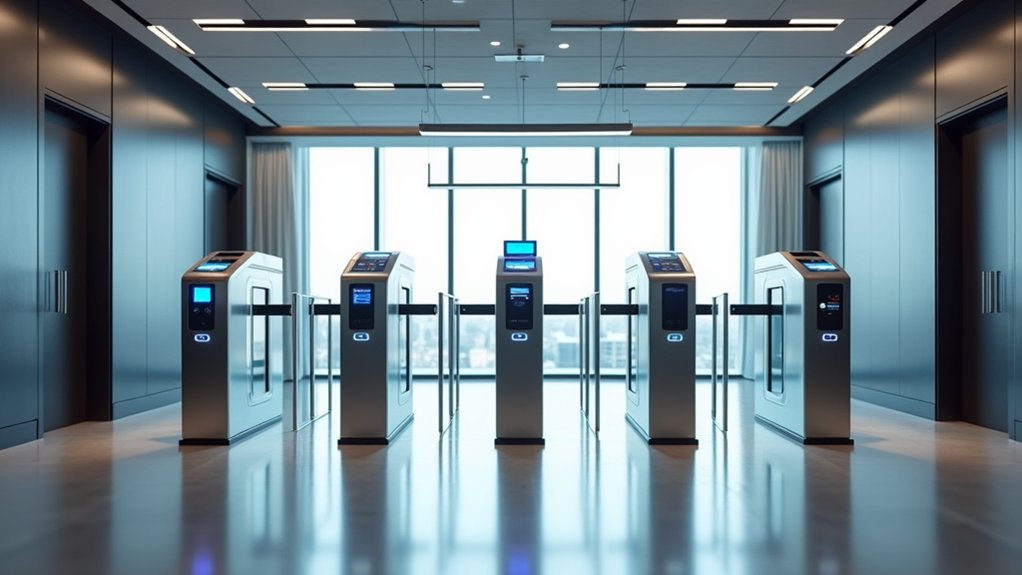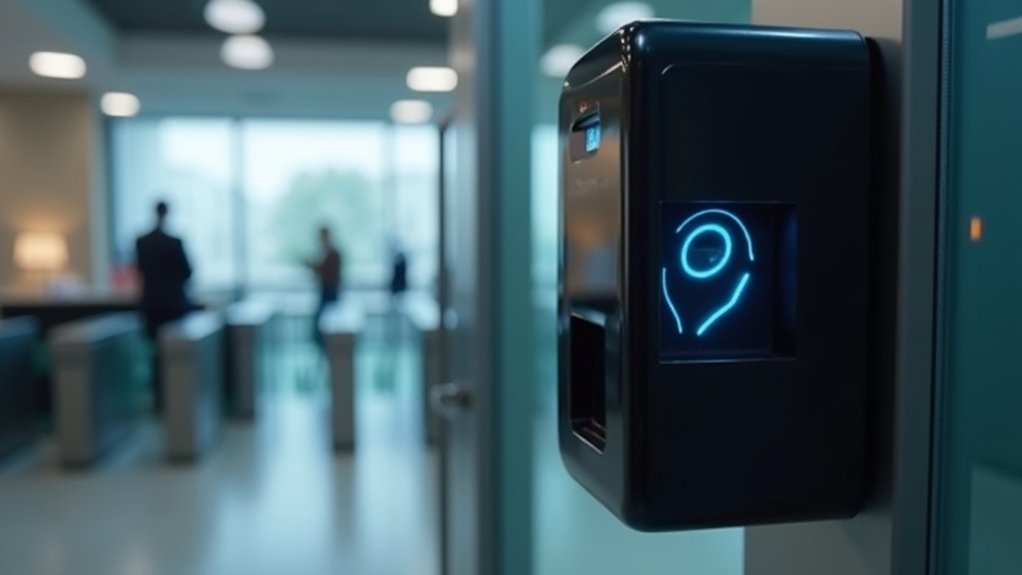Modern hands-free entry systems keep buildings safe by using phone-based passes and body-scanning technology. Online systems let managers control access from anywhere while keeping data safe and watching activity as it happens. Face scans, fingerprints, and eye scans work together to make sure only the right people get in. Security cameras add another layer of protection by connecting entry records with video footage. These smart tools create a complete safety plan for any building.
Key Takeaways
- Multi-factor biometric authentication combining facial recognition and eye scanning provides the highest level of touchless security verification.
- Cloud-based systems with real-time monitoring and automatic security updates offer robust protection against unauthorized access.
- Mobile credential solutions using encrypted digital keys and smartphone authentication ensure secure, contactless entry control.
- Integrated video management systems linking door controls with smart cameras enable comprehensive surveillance and threat detection.
- Intelligent software systems that detect unusual patterns and automatically respond to security threats provide proactive protection.
Understanding Modern Touchless Access Control

Traditional access control systems needed people to touch them, but today’s hands-free systems offer better security and cleanliness.
Modern systems use body-based checking methods like no-touch finger scanning and face scanning with smart cameras, keeping places secure without any physical contact.
Phone apps and internet-based security systems work together with these methods, letting people use their phones or smart watches to get in.
These combined security tools stop unwanted visitors while keeping places safe.
These new systems work especially well in busy buildings where safety and smooth operations matter most.
Biometric authentication systems provide enhanced security compared to traditional keys or passwords while eliminating the need to remember access credentials.
Mobile Credential Solutions and Security Features
Modern buildings are moving away from physical keys and cards to phone-based access systems that don’t require touching doors or readers.
These systems use strong security measures like data scrambling and multiple checks to keep out unwanted visitors, while letting building managers control who can enter in real-time.
The system protects digital keys by coding them when sent between devices.
Smart software watches how people come and go to spot odd behavior.
Each person gets their own special code to track their movements.
Managers can quickly change who has access from anywhere.
Using phones means no more handling physical cards or fobs.
When phone-based entry systems work together with smart security tools, they create a strong shield against break-ins.
This setup helps buildings stay secure while making it easy for the right people to enter without touching anything.
Networked systems offer scalable multi-point access control that can grow alongside facility expansion needs.
Biometric Authentication Technologies

Biometric authentication is a better way to control access without physical contact. It works by checking unique body features like fingerprints, faces, and eye patterns to make sure someone is who they claim to be. Unlike passwords or cards, these body markers can’t be copied or taken by others.
Fingerprint scanners quickly read the distinct patterns on fingertips for safe entry. Face scanning uses smart computer programs to measure and match facial features. Eye scanning offers a hands-free option by looking at the special patterns in people’s eyes that stay the same throughout life.
When these body-scanning methods work together with coded security and multiple checkpoints, they create strong barriers against unwanted entry. This new approach has changed how we keep spaces and information safe. Control panels manage all biometric components to ensure seamless operation and enhanced security across the system.
Cloud-Based Security Implementation
Cloud-Based Security Systems Today
Security systems now go beyond keys and cards by using cloud storage and control. These modern security tools let you watch and manage everything through online networks.
- You can control doors and gates from anywhere, seeing changes as they happen.
- Smart systems learn patterns to spot people who shouldn’t be there.
- The system keeps detailed records of who goes where and when.
- Safety updates happen automatically on all connected doors.
- Easy to add more doors and new users as needed.
These tools bend and grow with your needs, watching everything carefully.
This makes them perfect for companies that want strong, lasting security while keeping things running smoothly and following all the rules.
Managed IT services provide expert oversight to ensure cloud-based security systems remain optimized and protected against emerging threats.
Long-Range RFID and Bluetooth Solutions

Traditional access systems need you to be very close to work, but newer RFID and Bluetooth systems let you unlock doors from far away.
Long-range RFID tags can work from up to 30 feet away, while Bluetooth systems, especially those using BLE, can reach up to 800 feet.
These hands-free systems work better than old methods because they send data safely and use strong security, so you don’t need physical cards or keys anymore.
You can control everything through phone apps, making it easy to manage who gets in and get instant updates about entries.
This setup works really well in busy places where people need to get in quickly and safely without causing delays.
Integrated Video Management Systems
Modern Video Management Systems (VMS) make buildings safer by combining door control systems with live camera feeds.
These smart systems help security teams watch and respond to events quickly by putting all security information in one place.
The system:
- Links camera footage with door openings to show who enters and exits
- Uses smart tools to spot unusual entry patterns
- Works through the internet for easy control from anywhere
- Works with new technologies like face scanning
- Keeps track of everything through cameras and door sensors
When VMS works together with door security, it creates strong protection that lets the right people in while recording everything that happens in the building.
Cost Analysis and Return on Investment

The decision to invest in touchless access control systems needs a good look at both starting costs and future money savings. While phone-based keys and better security tools cost more at first, most companies find they save money over time through lower running costs and better protection.
The full price includes setup and upkeep, but the savings that follow make up for these costs. Companies that use touchless access control find their workers take fewer sick days and their entry systems work more smoothly.
Setting aside money for system updates helps keep security strong and saves money by stopping break-ins and making daily operations easier.
Deployment Strategies and Best Practices
Successful deployment of touchless access control systems requires organizations to conduct thorough security assessments and develop structured implementation plans.
The integration of mobile credentials and biometric solutions demands strategic coordination to guarantee seamless operation with existing infrastructure while maintaining robust security protocols.
- Conduct extensive analysis of security requirements and operational needs
- Implement phased rollout strategy to test system compatibility
- Provide thorough training programs to maximize user adoption
- Establish regular maintenance schedules and update protocols
- Deploy real-time monitoring systems for continuous security oversight
These deployment strategies and best practices enable organizations to effectively shift to touchless access control while maintaining security integrity and operational efficiency.
Regular evaluation of system performance guarantees continued effectiveness and adaptation to emerging security challenges.
Future-Proofing Your Access Control System

Looking ahead while setting up your access control system is just as important as meeting today’s security needs. To make sure touchless systems stay useful in the future, you need strong data protection and multiple ways to check who someone is before letting them in.
Good security systems can grow with your needs and work well with new tools as they come out. Pick systems that use smart computer programs to spot problems early and handle them automatically.
Keep the system’s software up to date to make sure it runs well and works with newer technology. When you plan carefully like this, your access control system can change and improve as your security needs grow.
Frequently Asked Questions
Which Access Control Method Is the Most Secure?
Using multiple security steps that include fingerprints or face scans, phone-based codes, and data scrambling offers better protection than single methods. This works by matching a person’s unique body features with digital proof of who they are, while keeping track of who goes where and letting managers control access from anywhere.
What Is the Best Access Control System?
Modern security systems work best when they combine online features with multiple ways to check who someone is. These include fingerprints, phone-based access, and special ID cards. The safest systems use face scanning, secure digital keys, and keep detailed records of who enters and exits.
What Is the Most Secure Access Control Model?
The strongest way to control access combines fingerprint or face scans with several layers of security checks, protected data, and clearly defined user roles. It tracks how people use the system, identifies their devices, and constantly checks for risks while following strict rules about who can access what.
Which Access Control Provides the Strongest Level of Protection?
Strong protection comes from using three security layers working together: body scanning (like fingerprints or face scans), phone-based keys, and secure digital records. This combined system checks who you are physically, what device you carry, and keeps detailed records of every entry, making it very hard to break in.
Conclusion
Touchless access control technologies continue to evolve, with biometric solutions and mobile credentials leading the way in security effectiveness. Nye Technical Services specializes in cloud-based systems with multi-factor authentication to protect against unauthorized access. When setting up these solutions, companies need to think about growth potential, following regulations, and making sure their current systems can work together. To keep access control strong as security threats get more complex, regular system checks and updates are key.



